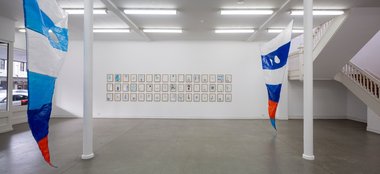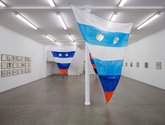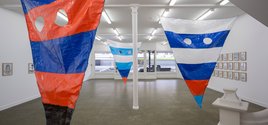John Hurrell – 17 June, 2015
From the accompanying blurb it seems that McGregor is very interested in myth and local cultural attributes, as arising from geographic, climatic and historical conditions. Yet his approach is not Structuralist as a form of tightly layered scientific research (or conceptual matrix) - which you might expect - juxtaposing instead references to scattered individual interests and qualities in a manner that is intuitive and playful.
In this introduction to the work of Melbourne artist, Laith McGregor, we find three types of portrait, all thematically interconnected and demonstrating great technical aptitude.
First of all there are the two sorts of drawing on paper: one - tight pencil renditions of heads, crammed with overlaid (letters erased from the graphite) or juxtaposed texts and symbolic masks; the other - much looser blue watercolour sketches, pencil doodles and scribbled notes, mixed with very fine inked profiles.
The other type of contribution, made of tarpaulin fabric, is a suspended isosceles triangle-shaped ‘crab claw’ sail, hanging from the ceiling. There are three of them. They have circular eye holes cut out so they look like ratfaced masks, their narrow pointed tips forming snouts that meet the floor, and feature in one of the pencil drawings.
The single row of nine largish framed pencil drawings - featuring the physiognomies of artist, family, and various personalities in the Australian art world - use lines of capital-lettered texts running together so words are blended into a continuous stream, and the blobby lettering looks vaguely as if it comes from head comix and Haight Ashbury, psychedelic posters. As is the convention with, say, Christopher Wool’s stencilled text paintings, you have to extract the sense out of each sentence: breaking it down into a sequence of groups of related letters, ie. words. These anthropological and personal ‘annotations’ go with other texts drawn via letters rubbed out on the graphite, and occasional superimposed masks. A lot of the textual and visual references allude to Balinese culture (and its particular variety of Hinduism), an island where the artist lived for a year.
To make this series, McGregor’s method has been to employ a street artist in Ubud to draw the central graphite portraits, these being based on photographs McGregor provided that he organised directly from the ‘sitters’. After he has collected the slick and accomplished renditions, McGregor then adds the other layers of mask or text, using a pencil, pen or subtracting eraser, improvising with a range of writing types and cartoon.
From the accompanying blurb it seems that McGregor is very interested in myth and local cultural attributes, as arising from geographic, climatic and historical conditions. Yet his approach is not Structuralist as a form of tightly layered scientific research (or conceptual matrix) - which you might expect - juxtaposing instead references to scattered individual interests and qualities in a manner that is intuitive and playful.
As explorations in portraiture, these may not be as innovative or as physically imposing as, for instance, Mike Parr’s charcoal self portraiture work of the early eighties, but their sense of full throttle / referential overload / textual surplus does make them very distinctive. It draws you in and you stay intrigued, irrespective of whether these heads - with their densely packed, layered texts, drawings, patterns and doodles - are profound musings, spiritually symbolic codifications, or simply banal.
They seem openly indiscriminate, as if each depicted self is only an accumulated collection of quotations, the bright and the cretinous all jumbled up together. Like endless rows of captioned buttons on a denim jacket, each phrase is a declared affiliation or some kind of community signifier. Yet the additions could have nothing to do with the sitter, being instead fanciful speculations projected on the part of the artist.
Looking at the opposite wall, its three rows of smaller and looser watercolour wash drawings (forty-eight in total) have less emphasis on graphite manipulation skills, though there is a lot of tight rendering with dark blue ink (virtuoso drawing by McGregor himself). These images are more fluid, sprawling and less dense - airy and yet focussed in their paired juxtaposition. Often they consist of nervous pale men drawn in greeny blue washes, hovering like phantoms behind intensely formed tribal carvings or masks, moodily rendered in crisp, dark pen lines.
Others are collages, or sheets with pencil and ink doodles scattered around pen and ink heads. These images seem to be tentative explorations that, after further ideational development, ended up generating the works on the other side of the room - considered couplings that eventually involved another artisan and McGregor’s replacing, ad hoc lettering improvisation.
John Hurrell






















 Two Rooms presents a program of residencies and projects
Two Rooms presents a program of residencies and projects Advertising in this column
Advertising in this column



This Discussion has 0 comments.
Comment
Participate
Register to Participate.
Sign in
Sign in to an existing account.